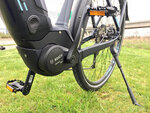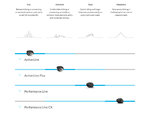Hi guys, I'm creating mini reviews for hardware like the Bosch Active Line Plus that is shared across many electric bikes. This tactic allows me to go deeper, make updates in one place vs. having details spread out across reviews potentially going out of date, and it aggregates your excellent comments and input to be shared more effectively. There are variations in implementation, which I'll highlight back in the full ebike reviews on EBR.
One of the first Bosch Active Line Plus motors that I saw in the wild was on the BULLS CRUISER E in 2017. It offered several important benefits compared with the standard Active Line drive unit and other compact, lightweight, urban-oriented, mid-drive motors from Shimano, TranzX, and Bafang. Some of the main benefits include:






This review is still in the works, I invite your input below to make this as comprehensive as possible.
One of the first Bosch Active Line Plus motors that I saw in the wild was on the BULLS CRUISER E in 2017. It offered several important benefits compared with the standard Active Line drive unit and other compact, lightweight, urban-oriented, mid-drive motors from Shimano, TranzX, and Bafang. Some of the main benefits include:
- Raw torque power, the Bosch Active Line Plus motor can deliver up to 50 newton meters of torque in the highest levels of assist, which is 10nm more than the standard Active Line drive unit and on par with other efficiency focused mid-drives. By comparison, the the Performance Line Cruise and Speed motors deliver 63nm and the Performance Line CX offers 75nm.
- Extremely efficient power use, mid-drive electric bike motors tend to be more efficient than hub motors because they can leverage a cassette, internally geared hub, or continuously variable transmission, in the same way that a rider does. If you shift to lower gears, it will climb without using as much energy... and if you shift to higher gears, it will maintain speed without using as much energy. The Active Line and Active Line Plus mid-drive don't spend power as quickly as their sportier cousins in the Performance Line group
- Decent pedal cadence support, the Bosch Active Line Plus motor can support up to 105 RPM, which means that you can spin farily quickly without losing a sense of power, it's particularly useful when downshifting to climb a moderate or steep hill. I often downshift and pedal at higher RPM because it reduces knee pressure. The lowest RPM support of 100 is offered by the base Active Line motor from Bosch and the Yamaha PW drive unit. By comparison, the Performance Line, Speed, and CX motors offer 120 RPM for sporty riding and mountain biking applications
- Fast to respond, the Bosch motor controller measures rear wheel speed, pedal cadence, and pedal torque over 1,000 times per second. This reduces the time required for the motor to kick in when you begin pedaling and cut out when you stop, it produces a natural ride feel that becomes more of an extension of your own pedaling than an on/off feel from more basic units that take fewer measurements or use simple cadence sensors. Bosch is the clear leader in this category because all drive units appear to use the same high sample rate (high resolution) sensor configuration and software, even the more affordable units like the Active Line and Active Line Plus
- It's fairly affordable! Compared to the Performance Line drive units, the Active Line Plus costs less for manufacturers to spec on their ebikes, and this is reflected in the end price. In my experience, it can be $500+ less
- Quiet and smooth, the Active Line Plus motor really balances the line between responsiveness, power, and reduced noise. It's one of my favorite drive units on the market because you just don't hear it as much. There's no reduction gearing system, so it uses a standard sized chainring that spins 1 to 1 with your pedal crank, and I think this helps it to be quieter, it also makes swapping chainrings easier
- Lightweight and compact, weighing in at roughly 7.1lbs (3.2kg) vs. 8.8lbs (4.0kg) for the Performance Line motors, this drive unit stays nearly hidden behind most chainrings and doesn't protrude as far forward. The casing is minimal and very compact... some companies even color match it to the frame! As with all mid-motors, the weight that does exist is kept low and centered on the frame
- Shift detection, the motor controller listens closely for pedal torque input with each pedal stroke while simultaneously listening for spikes in pressure resulting from shifter cables. When these signals are heard, the motor is told to back off momentarily to reduce wear and tear on the chain, sprocket, or internal gearing. Shift detection is imperfect in my experience, leaning more towards rider performance than drivetrain protection, but that's my preference as an advanced rider and it's less relevant on the Active Line motors which deliver less power and torque. Software driven shift detection is better than nothing, which is what most other mid-drives offer, and you can contribute to its effectiveness by easing off your pedal strokes when changing gears... just as you would with a traditional bicycle
- Durable crank arm interface, Bosch has designed their own Mini ISIS splined crank interface vs. using square tapered, this provides a tighter and more reliable crank connection point, much like the industry standard ISIS splined
- You can pedal backwards and the chain actually cycles backwards! Most mid-drive units have a freewheeling frictionless backpedal action that can actually get out of control if you bump the pedal, and they also don't cycle the chain. The benefits of having a bit of friction and cycling the chain is that the pedals stay where you expect them while riding and you can lube and adjust the chain and derailleurs without putting the bike into a stand
- Lower RPM support, even though I was praising the 105 RPM maximum support level just a moment ago in the pros section, I still see it as a big trade-off and something that limits your top speed when pedaling with lower gears, I have found that in order to reach the maximum supported speed of 20mph (32km/h) with most ebikes that use this motor, you definitely have to switch into the higher gears
- Resistance when pedaling backwards and stopping pedaling, I noticed that the gearbox inside the motor creates drag when pedaling the drive unit backwards. This isn't a huge deal, but it does seem create a "clunk" feeling when you stop pedaling forwards, almost like momentum from the gearbox is pushing on your foot before stopping entirely, it's not something I have experienced with most other mid-motors on electric bicycles, but they don't tend to stop as quickly as this motor does either... so I'm mixed on this one to be honest... if you'd rather have a longer but smoother fade out, consider the Brose T, Shimano E6000, Yamaha PW, Dapu, or Bafang MAX motors
- It appears that this drive unit can only support one chainring, this is a very minor consideration given the limited 105 RPM output, but is worth noting since the Yamaha PW drive unit would accommodate multiple rings, allowing you to expand the number of gears and achieve finer gear steps if desired (most manufacturers have not chosen to use multiple chainrings because it adds weight, drivetrain complexity, and is less necessary when you have a motor supporting your pedaling)






This review is still in the works, I invite your input below to make this as comprehensive as possible.

